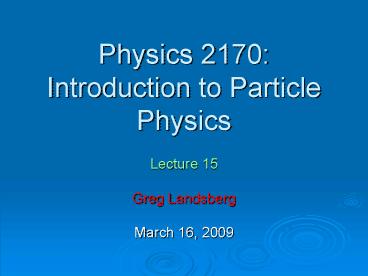Physics 2170: Introduction to Particle Physics - PowerPoint PPT Presentation
1 / 13
Title:
Physics 2170: Introduction to Particle Physics
Description:
In toy theory, coupling has dimensions of energy ... Not a full story yet: there is. another diagram obtained by. twisting the ... Lecture 15, 3/16/09. 13 ... – PowerPoint PPT presentation
Number of Views:23
Avg rating:3.0/5.0
Title: Physics 2170: Introduction to Particle Physics
1
Physics 2170 Introduction to Particle Physics
- Lecture 15
- Greg Landsberg
- March 16, 2009
2
Feynman Rules Recapped
- For EACH vertex in the diagram, introduce a
factor of ig, where g is the coupling - In real theories coupling is always
dimensionless e.g., e is EM coupling and e2/4p
a - In toy theory, coupling has dimensions of energy
- For EACH vertex, further write down four-momentum
conservation via a delta function
(2p)4d4(k1k2kn), where ki are four-momenta
coming INTO vertex (i.e., for the outgoing
momenta use ki)
3
Feynman Rules Recapped
- For EACH internal line, write a propagator
i/(qj2 mj2) - For EACH internal line put a factor d4qi/(2p)4
and integrate over all the internal momenta - Cancel the delta function the final result will
include a delta function of the type
(2p)4d4(p1p2pn), which is part of the Fermi
Golden rule erase it and multiply by i to get M
4
Example Lifetime of A
- Feynman rules
- Hence, M i (-ig) g
- Decay rate
- Here is the amplitude of either outgoing
momentum - The lifetime is then (g
GeV)
5
Example AA ? BB Scattering
- Feynman rules
- Lets integrate over the second delta function,
which sends q ? p4 p2 - Therefore
- Note that M 1, as expected
6
AA ? BB Scattering (contd)
- Not a full story yet there isanother diagram
obtained bytwisting the outgoing legs - Note that twisting incoming legs doesnt give
any additional diagrams as the only important
thing is whether p3 connects to p1 or p2 - One can get the amplitude via p3 ? p4
- As usual, the overall amplitude is the sum of the
two
7
AA ? BB Cross Section
- Suppose we would like to get differential cross
section in the c.o.m. frame for a simpler case
mA mB m and mC 0 - Here p is the absolute value of particle 1
momentum, which is the same as the momenta of
particles 2, 3, 4 - Hence
8
Higher-Order Diagrams
- So far we considered only the lowest order (tree
level) diagrams for AA ? BB scattering - There are many more
- There are 8 next-to-leading order diagrams
9
Next-to-Leading Order Diagrams
- We wont calculate them all, lets just consider
one self-energy diagram - Feynman rules give
Integrate over q1 and q4 using the first and last
deltas q1 ? p1 p3 q4 ? p4 p2
Now integrate over q2 using the first delta q2
? p1 p3 q3 cancel last delta
10
How to Calculate This Integral
- d4q q3dq dW (similar to 3D d3r r2dr dW)
- Thus the integral at large q can be approximated
as follows - This integral diverges at high q, thus making
quantum corrections infinite! - The problem held QED development for some 20
years, until Feynman, Tomonaga, Schwinger and
others found a solution, known as
renormalization procedure - The idea was to regularize the integral by using
an arbitrary cutoff, L, thus making it finite
11
Dealing with Infinities
- In the case of our problem, the regularization
can be achieved by inserting the following factor
under the integral - This of course appears completely arbitrary,
except that if one takes L to infinity, the
fudge-factor approaches 1 - However, with this factor, the integral can be
rewritten as a sum of two parts the finite one
and the diverging one lnL - Now, a magic thing is that ALL the divergent
pieces appear in the final expression ONLY as
additive terms to masses and couplings m ? m
dm g ? g dg
12
Renormalization
- The renormalization procedure basically replaces
bare masses and couplings with their
renormalized physical values - There is a minor problem these masses and
couplings approach infinity at infinite energies,
but as we measure them only at finite energies,
this is really an unphysical infinity - Cf. with self-energy of electric field around the
point-like electric charge which is infinite and
thus corresponds to the infinite mass via E m - Apart from these infinite terms, there are
perfectly calculable and finite terms that are
added to masses and couplings from loop diagrams - They cause running of the couplings and masses
13
Still Concerned?
- Renormalization procedure can be considered as a
way to parameterize unknown modifications to
quantum mechanics at very short scales - Usually when an infinity comes as a part of
solution, this merely means a limitation of the
theory - For example, if space-time is quantized there
exists a minimum length scale - Think about renormalized masses and couplings as
effective massive and couplings for a particle
propagating through a complex structure of
quantum vacuum - These effective variables parameterize properties
of quantum vacuum, not the particles per se













![L 33 Modern Physics [1] PowerPoint PPT Presentation](https://s3.amazonaws.com/images.powershow.com/7602675.th0.jpg?_=201602121011)


![L 35 Modern Physics [1] PowerPoint PPT Presentation](https://s3.amazonaws.com/images.powershow.com/7552279.th0.jpg?_=20160119094)



![L 34 Modern Physics [1] PowerPoint PPT Presentation](https://s3.amazonaws.com/images.powershow.com/7125701.th0.jpg?_=20150905079)










